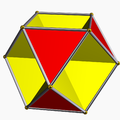Euler characteristic
In mathematics, the Euler characteristic of a shape is a number that describes a topological space, so that anything in the space will have the same number. It is calculated by taking the number of points in the shape, the number of lines in the shape, and the number of faces of the shape. One can find the Euler characteristic with this formula:
- [math]\displaystyle{ \chi=V-E+F \,\! }[/math]
where V is the point count, E the line count, and F the face count. For most common shapes (convex polyhedron), the Euler characteristic is 2.[1][2]
| Name | Image | Vertices (Points) V |
Edges (Lines) E |
Faces F |
Euler characteristic: V − E + F |
|---|---|---|---|---|---|
| Tetrahedron | 
|
4 | 6 | 4 | 2 |
| Hexahedron or cube | 
|
8 | 12 | 6 | 2 |
| Octahedron | 
|
6 | 12 | 8 | 2 |
| Dodecahedron | 20 | 30 | 12 | 2 | |
| Icosahedron | 
|
12 | 30 | 20 | 2 |
Euler Characteristic Media
Related pages
References
- ↑ "List of Geometry and Trigonometry Symbols". Math Vault. 2020-04-17. Retrieved 2020-09-25.
- ↑ "Euler characteristic | mathematics". Encyclopedia Britannica. Retrieved 2020-09-25.
- ↑ Weisstein, Eric W. "Euler Characteristic". mathworld.wolfram.com. Retrieved 2020-09-25.




